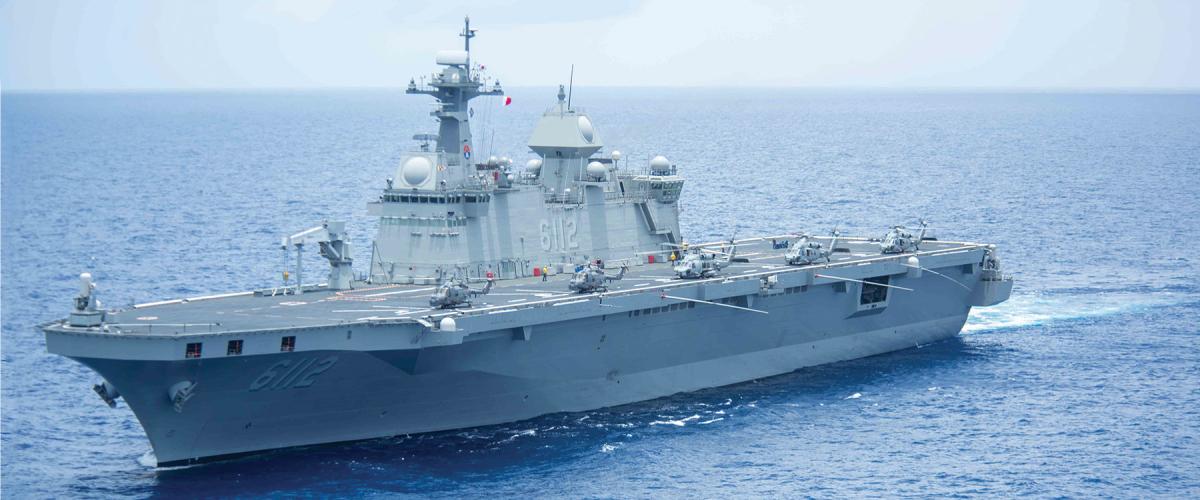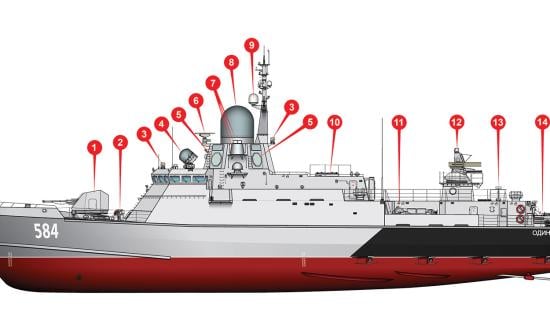Conceived under the Landing Platform Experimental (LPX) program, the Republic of Korea’s two Dokdo-class warships were built by Hanjin Heavy Industries and Construction in Busan. These two “big-deck” amphibious assault ships are the largest and among the most flexible surface ships in the South Korean Navy.
A contract for the namesake Dokdo was signed in September 2002 and construction began several months later. She was launched in July 2005 and entered service on 3 July 2007. Although a second ship had long been expected, a follow-on contract was not finalized until December 2014. Sister ship Marado was laid down on 28 April 2017, launched on 14 May 2018, and commissioned into service on 28 June 2021. The newer ship incorporates significant improvements into the initial Dokdo design.
Displacing some 19,000 tons when fully loaded, the Dokdo and Marado measure 655 feet long with a 105-foot beam and 21-foot draft. Four diesel engines provide 32,000 shaft horsepower for two shafts with controllable-pitch propellers. Top speed is 23 knots and cruising range is 10,000 nautical miles at 18 knots. Primarily tasked with amphibious assault, the ships have important secondary roles as joint command fleet flagships and humanitarian assistance platforms with extensive medical facilities.
Accommodations are available for 420 sailors, including regular crew and a naval command staff, plus a battalion of 720 marines, which reportedly could surge to 1,000 troops for brief periods if required. Heavy equipment—including main battle tanks, artillery, wheeled and tracked vehicles, and support equipment—can be transported belowdecks in the hangar. The ships feature a floodable well deck and each can operate two hovercraft, such as the U.S. landing craft air cushion (LCAC) or South Korean Solgae-class landing ship.
The Dokdo and Marado have large flight decks marked with five numbered helicopter landing spots on the port side and two spots aft of the island structure. A mix of 10–15 rotary-wing aircraft can be carried and operated, including a variety of helicopters such as the UH-60 Black Hawk/MH-60 Seahawk, KUH-1 Surion, Mk 99 Super Lynx, and even the CH-53E Super Stallion. The Dokdo can carry one MV-22 on its flight deck, while the Marado can accommodate two.
Sensors and weapon fits are markedly different between the two ships. While the Dokdo is fitted with the SMART-L and MW-08 search radars, the Marado carries the more advanced EL/M-2248 MF-STAR and SPS-550K Active Electronically Scanned Array radars. The older Dokdo is armed with two 30-mm Goalkeeper close-in weapon systems (CIWS) and one 21-tube Mk 49 launcher for RIM-116 RAM surface-to-air missiles. The Marado, by contrast, carries two 20-mm Phalanx Block 1B CIWS and four South Korean K-VLS cells containing 16 K-SAAM Haegung/Sea Bow missiles for point defense. Other variances between the two ships include different infrared search-and-track systems and modified locations for various sensors, weapons, and the island flight control tower. Current plans reportedly call for the older Dokdo to receive similar upgrades as the Marado by the late 2020s.







